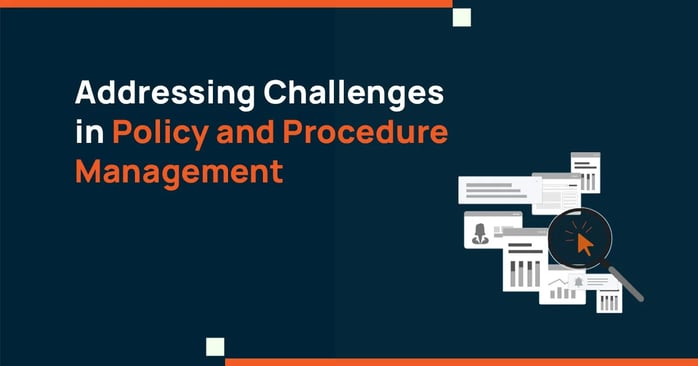Addressing Challenges in Policy and Procedure Management

Keeping it together
We’ve all sat in meetings, and more meetings, trying to hash out policy guidelines. It takes time. It takes multiple meetings. It takes dealing with different people from diverse areas both inside and outside the organization. It takes a lot of emailing back and forth after the meeting. And it can get confusing trying to keep track of it all.
One thing that is imperative for good policy management is being able to take all the pieces of information and keep them organized in one place.
Challenges in Policy and Procedure Management
Often competing agendas between the parties create silos of information instead of one communal pot of information. The policy making process grinds to a halt if one group has information the others don’t, and discussions become difficult when everyone is not on the same page. Dissension comes when others feel left out simply because someone forgot to forward critical emails.
Another impediment to policy making is information flow bottlenecks, where one person or department is holding up the entire process by sitting on emails that need to be passed on to others. Bottlenecks occur when someone doesn’t have access to information they need to make a decision. So everyone has to wait until the information is located. It can be frustrating and slow to get things done this way.
When a section or module is completed, there needs be a way to keep it all in one cohesive information hub, and a sane way of handling the approval process so no one gets left out. Or worse yet, so no one is approving a policy without having all the pertinent information and changes readily available to them.
Current Solutions are Inefficient
Spreadsheets add extra work, and require everybody to be timely and consistent about sending information to the person maintaining the spreadsheet. It’s hard to keep up with who is accountable for what without building a monster spreadsheet that no one can understand.
Keeping up with everyone submitting updates at the same time becomes a nightmare when trying to figure out which version is the current one.
And making sure everyone who is supposed to have the documents has them, is a totally different nightmare if the wrong version is accidentally sent out, or confidentiality is breached because someone who isn’t supposed to see a document gets it in a reply to all mishap.
A Robust Policy Management Software Solution
ConvergePoint’s SharePoint Policy Management Software is specifically designed to handle the multiple user, multi-site, multi-version, multi-update and multi-level approval structure of policy making. The Microsoft SharePoint platform that allows you to keep all your documents, from ideation through final policy, in one place.
The software uses SharePoint, which means all the data is kept securely on your servers, allowing everyone on the project to access information when they need it, no matter where they are, so no one’s desktop computer becomes a graveyard of policy documents. Computer crashes will never derail the policy-making progress either.
The approval process is easily managed by setting varying levels of access (permissions) for each user, so no one accidentally sees information or documents they aren’t approved to view. Each person can make their approval based on real time data, not on what happened three versions ago. Each approval notification records when it was sent out, who responded to it and when approval was given, making it easy to see who is holding things up in the organization so you can eliminate bottlenecks.
Read More: 10 Reasons to Choose Office 365 Policy Management Software

.webp?t=1681979613731)